Servicing a Microwave Oven
| HOME | Troubleshooting | DIY Tips |
|
.. When a microwave oven begins to cook erratically, the fault may lie with one of several easy-to-service components within the machine. If it stops working altogether, first check that the cord has not become unplugged and that the circuit breaker has not tripped. Defective Door Switches: The parts that fail most often are door- interlock switches. A faulty one can keep the oven from turning on and cause it to turn off unexpectedly. As many as five switches may be present, one behind each door latch and others positioned around the door perimeter. Test each one in turn as shown. Other Culprits: If a door switch is not to blame—and the oven light stays off when the door is open— check for a blown fuse inside the appliance. Next test the diode; diagnosis of electronic control panels is best left to a professional. However, if your oven has a dial timer and a mechanical start button, you can test two additional switches where problems originate. CAUTION---An interior component called a capacitor stores an electric charge that can deliver a strong shock. Discharge the capacitor before any test or repair. The procedure -- can produce a large spark. Anatomy of a microwave oven. 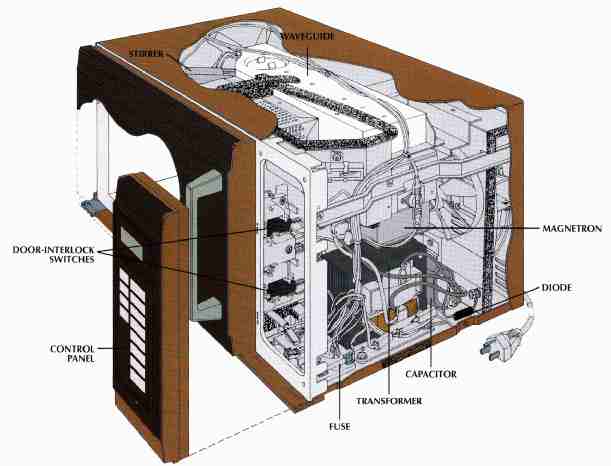
The heart of a microwave oven is a magnetron, which produces micro waves that travel through a waveguide into the oven. A stirrer bounces the waves around the cooking chamber, where they heat the food. Supplying the magnetron with power are a trans former, a capacitor, and a diode. These components boost 120-volt alternating- current household service to direct cur rent (the kind provided by a battery) at 4,000 volts. A control panel on the front of the oven provides for the selection of cooking times and cycles. Safety devices include door-interlock switches, which prevent the unit from starting with the door ajar, thus prohibiting harmful microwaves from escaping, and a fuse that protects the unit from power surges. — MAGNETRON; CONTROL PANEL; DOOR-INTERLOCK; SWITCHES Removing the cover and discharging the capacitor. 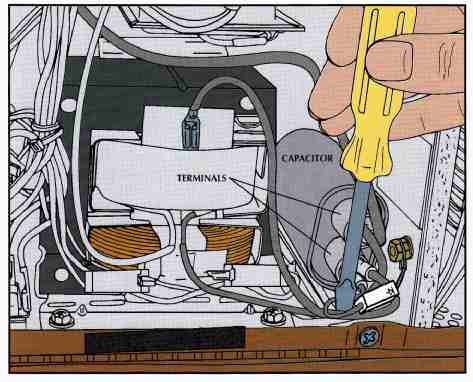
• Unplug the oven, then remove the screws that secure the cover. Set the cover aside. • Hold an insulated screwdriver by the handle, and lay the shaft across the metal sleeves on the capacitor’s two terminals. • If this produces a spark, touch the screwdriver to the terminals again to completely discharge the capacitor. If this procedure produces no spark, the capacitor has already discharged. UNIVERSAL MICROWAVE REPAIRS Checking the fuse. 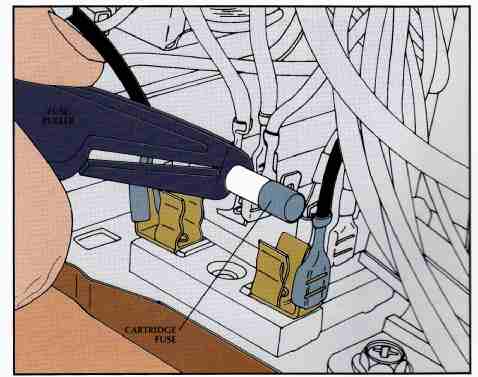
• With the oven unplugged and the cover off, locate the fuse, usually a cartridge fuse. • Pull the fuse from its holder with your fingers or with a fuse puller if your fingers can’t dislodge it. • To test the fuse for resistance, touch a probe of a multitester to each end of the fuse. • If the tester reads infinite ohms, the fuse is blown; replace it with a fuse of equal amperage. Replacing a diode. 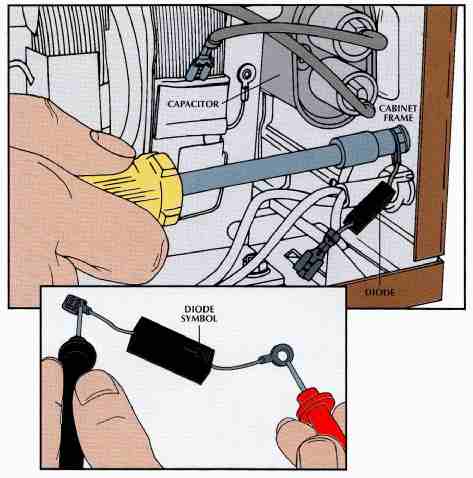
• Locate the diode, which is connected to the capacitor and to the frame of the cabinet. • Disconnect the diode from the capacitor and the cabinet -- and examine it. Replace a diode that is cracked or burned. • If there is no visible damage, set a multitester to RX1 K and calibrate it. Touch a probe to the end of each wire (inset), and note the multitester reading. Then reverse the probes and check the reading again. One reading should indicate a resistance of several thousand ohms, the other infinite ohms. If the diode fails the test, replace it. • Connect the new diode as the old one was connected. If the wires end in identical fittings, attach the one nearer the diode symbol to the cabinet. Testing a door switch. 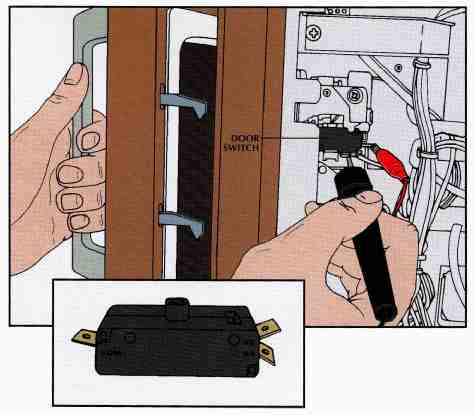
• With a two-terminal switch, remove the wire from one of the terminals and check the switch for resistance --, first with the door open (infinite ohms), then with it closed (0 ohms). Replace the switch if it fails either test. • If a door switch has three terminals, detach all three wires, then touch one probe to the COMMON terminal and one to the OPEN or NO terminal. A working switch will register 0 ohms with the door closed, infinite ohms with it open. • Next, check for resistance between the COMMON terminal and the CLOSED or NO terminal with the door both open (0 or zero ohms) and closed (infinite ohms). If the switch fails either test, replace it. TESTING NONDIGITAL MICROWAVES Identifying a faulty timer switch. 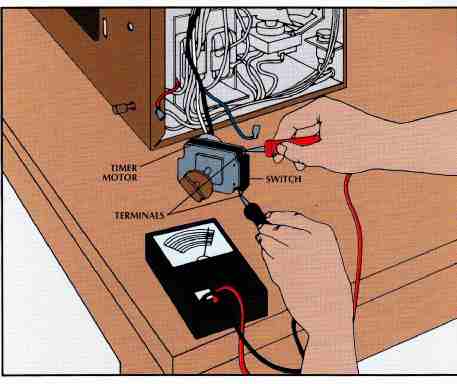
• Unscrew the timer assembly from the inside front panel and detach the wires from the two switch terminals, located on the back of the timer next to its motor. • Set a multitester to RX1, set the timer for at least 1 minute, then touch the tester probes to the switch terminals --. Replace the switch if the meter registers more than 0 ohms. On some ovens the timer switch is integrated with the timer and cannot be bought separately. Replace the entire timer assembly. Testing the start switch. 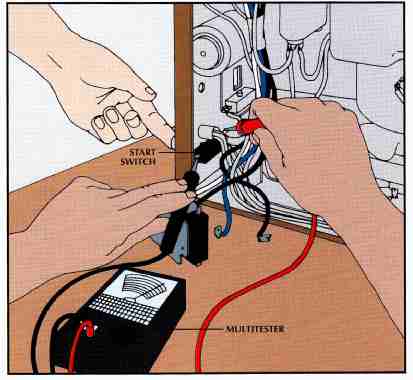
• Disconnect the wires from the terminals on the switch behind the start button. • Touch multitester probes to the switch terminals. There should be resistance of infinite ohms. • Have a helper push the button; the meter should read 0 ohms while the button is depressed. • If the switch fails either test. replace it by unscrewing or unclipping it from the timer assembly. Install a new one, and connect the wires to as terminals. Prev: Dealing with a Stuck Garbage Disposer Next: When an Electric Range Fails to Heat Home Similar articles top of page |